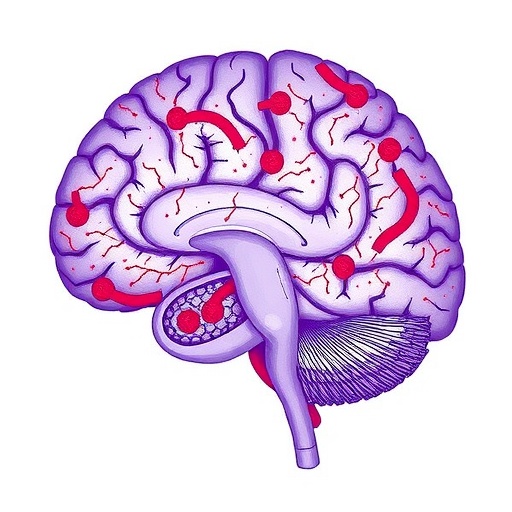In a groundbreaking study published in Nature Communications, researchers have unveiled a novel population of immune cells that could redefine our understanding of autoimmune encephalitis. This complex neurological disorder, characterized by the immune system’s attack on the brain, has long puzzled scientists seeking to pinpoint the exact cellular culprits behind its pathogenesis. The team, led by Perriot, Jones, and Genolet, employed state-of-the-art single-cell technologies to identify a distinct subset of cytotoxic T cells, marked by the expression of killer immunoglobulin-like receptors (KIRs) alongside the CD8 surface molecule, that appear to target neurons directly.
Autoimmune encephalitis represents a spectrum of conditions with severe neuroinflammatory consequences. Traditionally, research has largely focused on antibody-mediated mechanisms, but the role of T cells has remained less clear. The discovery of KIR-positive CD8+ T cells reactive to neuronal antigens hence provides a fresh perspective, suggesting that these cytotoxic lymphocytes participate in driving the inflammation and tissue damage characteristic of the disease. These cells exhibit a unique transcriptional profile that aligns with the induction of encephalitic pathology, integrating signals of neuronal recognition with effector functions.
Delving into the molecular phenotype of these immune cells, the researchers applied advanced RNA sequencing methods to map the gene expression landscape, revealing an “encephalitogenic” program that equips these T cells for their hostile role within the central nervous system. This includes upregulation of genes involved in cytotoxicity, inflammatory signaling, and cellular migration, all of which likely contribute to the severity and progression of autoimmune encephalitis. The coordinated activation of these pathways paints a detailed picture of how the immune system transitions from surveillance to aggression against neuronal tissue.
Furthermore, the study elucidates the significance of KIR molecules as markers and potential mediators of T cell activity in this context. KIRs are traditionally known for their regulatory roles in natural killer cells and some T cell subsets, modulating immune responses via recognition of specific HLA class I molecules. The presence of KIRs on CD8+ T cells in autoimmune encephalitis suggests a specialized mechanism through which these cells discern and target neurons, potentially exploiting altered or stressed neuronal surface markers to initiate immune attack.
Beyond the phenotypic characterization, functional assays confirmed the cytotoxic capabilities of these KIR+CD8+ T cells toward neurons. This reveals a direct pathogenic mechanism, distinguishing these cells from merely bystanders or secondary responders. The insights gained here hint at a feedback loop where neuronal stress or damage promotes recruitment and activation of these T cells, which then exacerbate neurodegeneration. Understanding this loop opens new avenues for therapeutic intervention that are immune-cell specific and might halt or slow disease progression.
The study also underscores the complexity of immune-cell interplay within autoimmune encephalitis, indicating that a concert of immune effectors contributes to the clinical manifestations. While B cell-produced antibodies continue to be critical in many patients, these neuron-reactive cytotoxic T cells add an additional layer of immune dysregulation. Therapies targeting these distinct T cell subsets could refine patient-specific treatment plans, moving beyond broadly immunosuppressive drugs toward precision immunotherapy.
Crucially, the research team deployed multi-dimensional cytometry to validate their findings across patient samples, cementing the reproducibility and clinical relevance of this KIR+CD8+ T cell subset. This translates molecular observations into a tangible biomarker that could potentially be used for diagnosis or monitoring of autoimmune encephalitis activity. The expression profile and frequency of these cells in cerebrospinal fluid and brain tissue may correlate with disease severity, providing a valuable tool for clinicians.
This discovery has profound implications not only for autoimmune encephalitis but also for broader neuroimmunology. The identification of neuron-reactive cytotoxic T cells challenges existing paradigms where antibody-mediated mechanisms dominate the field. It invites a reassessment of similar conditions where T cell roles may have been underestimated. Additionally, these findings may illuminate common pathogenic processes in other neuroinflammatory disorders, such as multiple sclerosis or paraneoplastic neurologic syndromes.
The technological sophistication of the study is notable as well. By leveraging single-cell RNA sequencing and high-parameter flow cytometry, the researchers could dissect the immune landscape with remarkable resolution. These techniques permitted the distinction of subtle but clinically important immune populations, previously obscured in bulk analyses. As such, this methodology exemplifies the power of modern immunology tools in decoding complex diseases and underscores the value of precision medicine approaches.
Moreover, the detailed transcriptional signatures identified open up potential targets for drug development. Molecules and pathways upregulated in these encephalitogenic T cells could be pharmacologically modulated to suppress their activity or prevent their recruitment to the brain. For instance, blockade of specific cytokines or chemokine receptors might disrupt harmful T cell migration or effector function, offering a new therapeutic angle that complements existing treatments.
The findings also highlight the dynamic nature of the immune response within the central nervous system environment. Neuronal stress or injury appears to create an immunological niche favorable for the expansion of these autoreactive T cells. Investigating the triggers for this immune activation, including viral infections or genetic predispositions, will be pivotal in understanding how autoimmune encephalitis initiates and evolves. It raises intriguing questions about the interplay between environmental factors and intrinsic immune dysregulation.
Future studies will undoubtedly explore how these KIR+CD8+ T cells interact with other immune players, such as microglia and astrocytes, within the neuroinflammatory milieu. The brain’s immune landscape is uniquely specialized, and decoding these interactions at a cellular and molecular level will enhance the ability to manipulate pathological responses without impairing protective immunity. This could minimize collateral damage often seen with broad immunosuppressive therapies currently in use.
Beyond translational insights, this work contributes fundamentally to the field of neuroimmunology by characterizing a previously unappreciated aspect of immune surveillance gone awry. It exemplifies how immune cells initially designed to protect against infections and malignancies can become pathogenic under certain conditions, highlighting the fine balance between immunity and autoimmunity within the brain. Such knowledge enhances our capability to harness or restrict immune functions for neurological health.
In summation, the identification of neuron-reactive KIR+CD8+ T cells as key drivers of autoimmune encephalitis marks a significant advance in neuroimmunology research. It bridges gaps in understanding disease mechanisms, opens promising therapeutic avenues, and exemplifies the transformative impact of cutting-edge immunological techniques. As research continues, these findings may lead to better diagnostic markers and more effective, targeted treatments, improving outcomes for patients suffering from this devastating disorder.
This seminal investigation not only redefines a key cellular player in autoimmune encephalitis but also sets a precedent for exploring pathogenic immune cells in other brain diseases. Integrating these discoveries with clinical practice promises to usher in a new era of personalized neuroimmune medicine, where treatments are tailored to the unique immune landscapes of individual patients.
The broader impact of this study resonates beyond neurology, touching on fundamental immunological principles related to self-tolerance, immune regulation, and inflammation. It challenges the scientific community to consider novel immune cell phenotypes and functions in diverse disease contexts, inspiring future research that may unravel new pathophysiological mechanisms and therapeutic targets.
Subject of Research: Immune mechanisms underlying autoimmune encephalitis, focusing on neuron-reactive KIR+CD8+ T cells and their pathogenic role.
Article Title: Neuron-reactive KIR+CD8+ T cells display an encephalitogenic transcriptional program in autoimmune encephalitis.
Article References:
Perriot, S., Jones, S., Genolet, R. et al. Neuron-reactive KIR+CD8+ T cells display an encephalitogenic transcriptional program in autoimmune encephalitis. Nat Commun 16, 8568 (2025). https://doi.org/10.1038/s41467-025-63573-1
Image Credits: AI Generated
Tags: autoimmune encephalitisbrain-targeting immune responsescytotoxic T lymphocytes in autoimmunityimmune cell discoveryimmune system and neurological disordersKIR-positive CD8 T cellsneuroinflammation mechanismsneuronal antigen targetingnovel therapeutic targets for encephalitissingle-cell technologies in immunologyT cell-mediated brain inflammationtranscriptional profiling of immune cells





